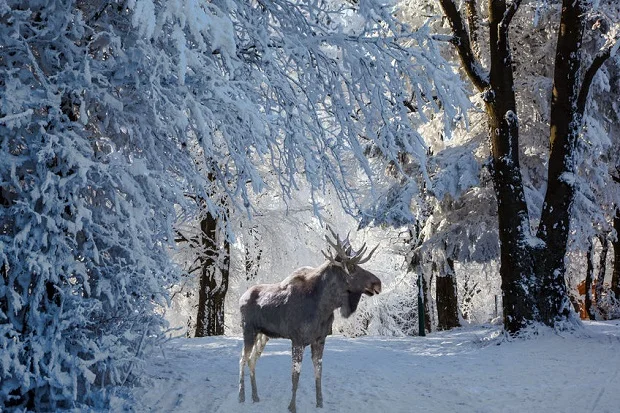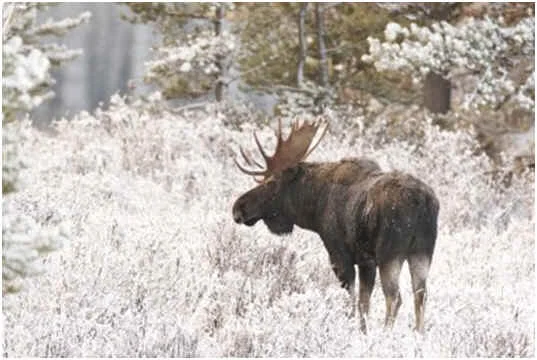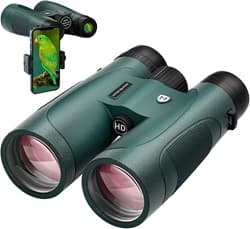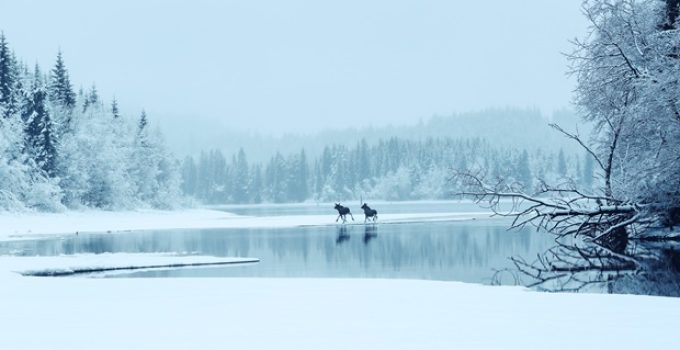Do Moose Hibernate or Migrate?
Answer at a Glance: Moose do not hibernate or migrate. They survive winters through adaptations that include physical, behavioral, dietary, and physiological.
Jump Ahead
- Physical Adaptations That Help Moose Survive Winter
- Behavioral Adaptations That Help Moose Survive Winter
- Dietary Adaptations That Help Moose Survive Winter
- Physiological Adaptations That Help Moose Survive Winter
- References
Physical Adaptations That Help Moose Survive Winter

In North America, moose roam the northern continental United States, Canada, and Alaska, where the climate can become extremely cold. Yet, these resilient creatures have adapted to these harsh conditions.
Their bodies are perfectly adapted to life in these winter climates.
The moose’s first line of defense against the cold is its unique winter coat. Composed of long guard hairs and a soft undercoat, this dense, insulating layer is not just any coat. The hairs are hollow, a feature that traps heat and helps the moose retain body warmth. [1]
Their bodies can retain massive fat stores that help sustain them during the food-scarce winter months, and their low surface-area-to-volume ratio, due to their large size, helps conserve heat. [2]
Additionally, their long legs enable them to move through deep snow, thereby reducing energy expenditure and facilitating access to food sources such as trees and shrubs. [3]
Behavioral Adaptations That Help Moose Survive Winter

Moose reduce their movement in winter to conserve energy, often limiting themselves to small areas known as “core areas.” These areas typically provide better shelter, food availability, or easier movement (like places where the snow is less deep). Staying within a core area helps moose conserve energy by limiting unnecessary travel and exposure to harsh conditions. [4]
Under certain conditions, moose may “yard up” — congregate in small groups in areas with favorable conditions (e.g., less snow, better shelter, or more food). This behavior is more common in deer but has been observed occasionally in moose. [5]
Moose use coniferous forests (like spruce and fir stands) for shelter from wind and cold. The tree canopy reduces snow depth and provides windbreaks. [6]
Dietary Adaptations That Help Moose Survive Winter

In winter, moose shift from aquatic vegetation and leafy plants to woody browse such as twigs, bark, and buds of willows, birch, and aspen. What’s interesting is that they don’t just eat any twigs. They selectively browse high-nutrition twigs and may strip bark from certain trees to meet their dietary needs. [7]
Physiological Adaptations That Help Moose Survive Winter

Moose reduce their metabolic rate slightly during winter, conserving energy when food is scarce. [8] They also possess a four-chambered (ruminant) stomach that enables them to efficiently digest tough, fibrous woody browse—an essential winter food. This sophisticated digestive system, coupled with a microbial ecosystem, allows them to extract energy and nutrients from twigs, bark, and wood. [9]
References
- [1] Alaska Department of Fish and Game – “Ask a Biologist – The Air in Moose Hair.”
- [2][3] Lundmark, Hans. Morphological and Behavioural Adaptations of Moose to Climate, Snow, and Forage. Swedish University of Agricultural Sciences, Dept. of Wildlife, Fish, and Environmental Studies, 2008.
- [4] Delgiudice, Glenn D., et al. “Home Range and Habitat Use of Adult Female Moose.” Alces, vol. 49, 2013, pp. 29–39.
- [5] Proulx, Gilbert. Characteristics of Moose Winter Yards in Southern Québec. Ministère du Loisir, de la Chasse et de la Pêche, Direction de la recherche sur la faune, 1983.
- [6] Balsom, Stephen. “Mature Coniferous Forest As Critical Moose Habitat.” Alces, vol. 32, 1996, pp. 131–140.
- [7] Seaton, Kristine L. Winter Foraging Ecology of Moose in the Tanana Flats, Alaska. M.S. thesis, University of Alaska Fairbanks, 2002.
- [8] Anne Randi Grysli et al.: Seasonal hypometabolism in female moose, Frontiers in Ecology and Evolution, 2020
- [9] Ishaq, Suzanne L, and André-Denis G Wright. “Insight into the bacterial gut microbiome of the North American moose (Alces alces).” BMC microbiology vol. 12 212. 19 Sep. 2012, doi:10.1186/1471-2180-12-212
Related Products

15×52 HD Binoculars for Adults
High Powered with Upgraded Phone Adapter – Large View Binoculars with Clear Low Light Vision – Lightweight Waterproof Binocular for Bird Watching Travel Hunting Cruise
